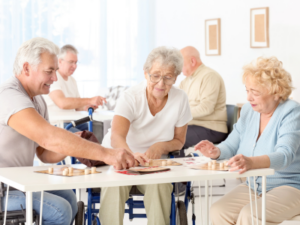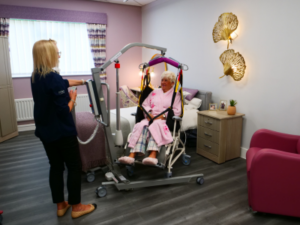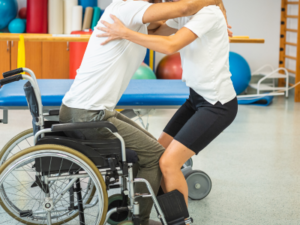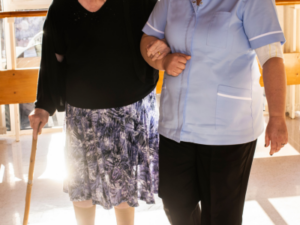 As society ages, the demand for day-to-day living support continues to rise. However, social care faces challenges amidst this growing need, particularly with funding cuts that have led to staff shortages and reduced training opportunities. In navigating these troubled waters, ensuring the safety and well-being of carers and those they support becomes paramount. If you have concerns regarding the safe handling of a loved one, we encourage you to contact your local social services department and request an Occupational Therapy review of the moving and handling risk assessment and plan.
As society ages, the demand for day-to-day living support continues to rise. However, social care faces challenges amidst this growing need, particularly with funding cuts that have led to staff shortages and reduced training opportunities. In navigating these troubled waters, ensuring the safety and well-being of carers and those they support becomes paramount. If you have concerns regarding the safe handling of a loved one, we encourage you to contact your local social services department and request an Occupational Therapy review of the moving and handling risk assessment and plan.
The Importance of Proper Lifting Techniques
 In healthcare environments, moving and lifting individuals is a common task that demands precision and care. Any ‘caregiver’ that needs to move or lift a person is at a high risk of lumbar complaints or disorders.1 When performed correctly, it enhances independence and quality of life while minimising the risk of injury.2 A 2013 study testing different patient transfer types showed that the lumbar load was considerably reduced when using optimised techniques or assistance aids.3 However, inadequate training and improper techniques can result in accidents and discomfort for carers and clients.
In healthcare environments, moving and lifting individuals is a common task that demands precision and care. Any ‘caregiver’ that needs to move or lift a person is at a high risk of lumbar complaints or disorders.1 When performed correctly, it enhances independence and quality of life while minimising the risk of injury.2 A 2013 study testing different patient transfer types showed that the lumbar load was considerably reduced when using optimised techniques or assistance aids.3 However, inadequate training and improper techniques can result in accidents and discomfort for carers and clients.

Examples of moving and handling in a health and social care environment include helping a client with the following:
- Sitting, standing or walking
- Sitting up or getting in or out of bed
- Using a toilet or a commode
- With bathing
- Following a fall
Understanding Controversial Lifting Techniques
While no techniques are classified as illegal in the UK, some methods, often called “Controversial Lifts,” pose significant risks and should not be used in normal care settings. These techniques, such as the Drag Lift or Australian Lift, can strain the carer and the client, potentially leading to injuries and a loss of dignity. As such, they are reserved for use in emergencies, where an individual’s life is at risk.
Drag Lift
 Also known as the underarm lift, this is when the client is lifted or supported under the armpit. It is typically used to lift someone up the bed, support them from sitting to standing or help them from the floor. It is done by hooking the elbow around the client’s arm, just under the armpit, and dragging them to the desired position.
Also known as the underarm lift, this is when the client is lifted or supported under the armpit. It is typically used to lift someone up the bed, support them from sitting to standing or help them from the floor. It is done by hooking the elbow around the client’s arm, just under the armpit, and dragging them to the desired position.
The drag lift does not promote active movement from the client and may encourage more passive behaviour, potentially leading to increased dependence.
This approach puts extreme strain on the client’s shoulder and the carer’s back. It can also create shear forces, leading to skin damage.
Australian Lift
Also known as the shoulder lift, this is typically used to help the client sit up in bed. The Australian lift takes two carers, one on either side. Each carer places a shoulder under the client’s armpit and hoists them up. The patient is then dragged backwards towards the headboard.
As with the drag lift, this approach can unnecessarily strain the client’s shoulder and the carer’s back. As the client is dragged back towards the headboard, the carers are moving backwards, leading to an increased chance of falls and injuries.
Orthodox Lift
Also known as the cradle, traditional or armchair lift, this is another lift that takes two carers. A carer stands on either side of the client, and they join hands to form a cradle with their hands, arms and wrists.
This approach puts excess strain on the carer’s arms and back and presents a high risk of dropping the client.
Combined Lift
Another lift for two carers, in which one uses their shoulder to lift, and the other places their hand on the client’s sacrum. They place a sling under the person’s thighs with their free hand to prepare them for a mechanical lift.
Although a sling is recommended when lifting, the combined lift is a poor method of placing the sling. This approach can lead to skin damage through shear forces and puts extreme strain on the client’s shoulder and the carer’s back.
Bear Hug Lift

The Bear Hug Lift assists a person from seated to standing. The carer leans forward, squatting and reaching forward under the person’s armpits, before standing to lift the person.
This approach puts unnecessary pressure on the caregiver and makes it hard for the person to stand under their own strength, as there is limited space around their feet.
Neck Hold
The Neck Hold is another method to assist a person from seated to standing. In this approach, the person puts their arms around the neck of the carer, relying on the carer’s momentum as they rise to pull the person to a standing position.
This approach puts a lot of strain on the carer’s neck, and there is a high risk of injury if either person loses their balance.

Flip Turn on a Bed
To roll a person onto their side in bed, it is necessary to have the person close to the carer, allowing them to be rolled away in one simple movement. However, to get the person close, the carer is reaching out, taking the load at a distance from the body and increasing the risk of strain.
Walking a Person Linking Arms
When transferring someone across short distances, the carer may be tempted to link arms with the client. However, the carer risks taking most of the client’s body weight, and if one of them stumbles, both will likely fall and potentially injure themselves.
The Importance of Training and Equipment
To mitigate risks and promote safe lifting practices, comprehensive training and the use of appropriate equipment are essential3. Investing in regular Moving and Handling training ensures that carers stay updated on the latest techniques, empowering them to provide effective care while prioritising safety.
Recommended Publications and Resources
- The Health and Safety Executive (HSE) provides valuable guidance on moving and handling in health and social care environments.1
- Organisations like HME Training and Athena Handling Ltd offer a range of courses tailored to the needs of healthcare professionals, ensuring they have the necessary skills to handle lifting tasks safely and efficiently.
- Various moving and handling equipment, including mobile hoists, ceiling track hoists, and stand and transfer aids, support individuals’ safe lifting and transfer. Proper selection and use of equipment can significantly reduce the risk of injuries3. Prism Medical UK equipment features a QR code, which, when scanned, will take users to an electronic version of the user manual, meaning that instructions on proper use are always available.
Summary
As we continue to navigate the complexities of social care, prioritising safe lifting practices is crucial. By investing in training and using appropriate equipment, we can ensure the well-being of carers and those they support, fostering independence and dignity in healthcare environments.
References
- Smith J. (2005) The Guide to the Handling of People. 5th edn. Teddington, UK: National Back Pain Association and Royal College of Nursing.
- Health and Safety Executive (HSE) – Moving and handling in health and social care. https://www.hse.gov.uk/healthservices/moving-handling.htm
- Jäger, M., Jordan, C., Theilmeier, A., Wortmann, N., Kuhn, S., Nienhaus, A., & Luttmann, A. (2013). Lumbar-Load Analysis of Manual Patient-Handling Activities for Biomechanical Overload Prevention Among Healthcare Workers. The Annals of Occupational Hygiene, 57(4), 528-544. https://doi.org/10.1093/annhyg/mes088




